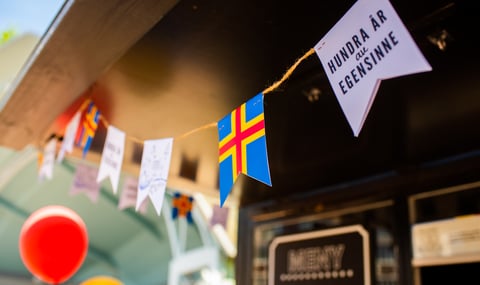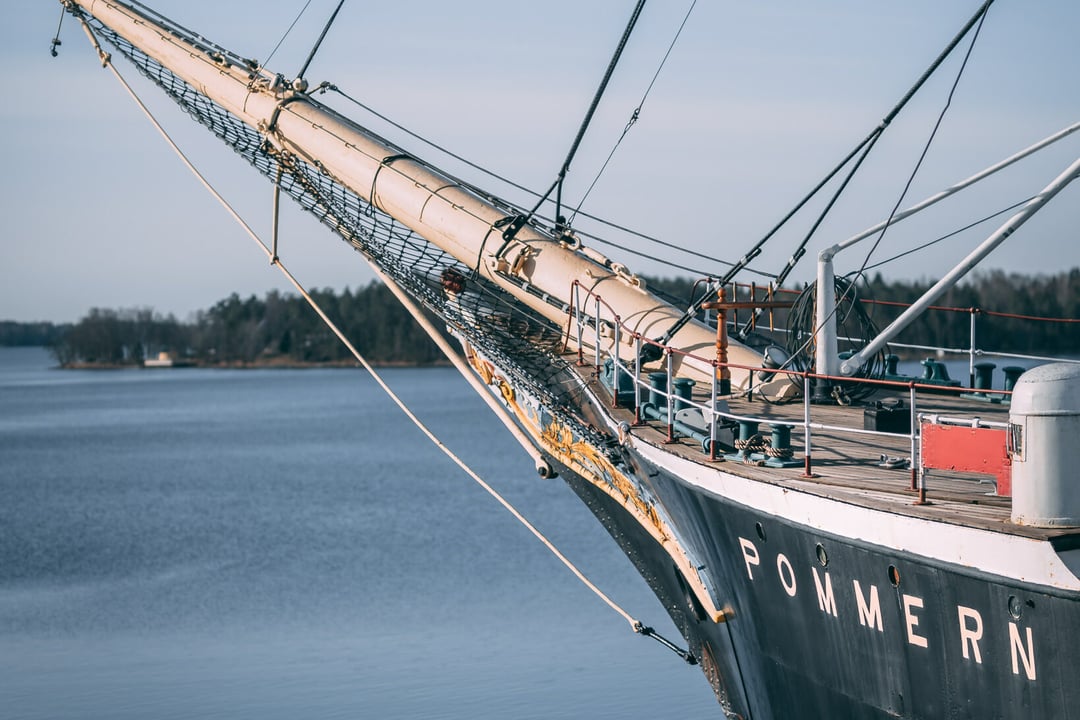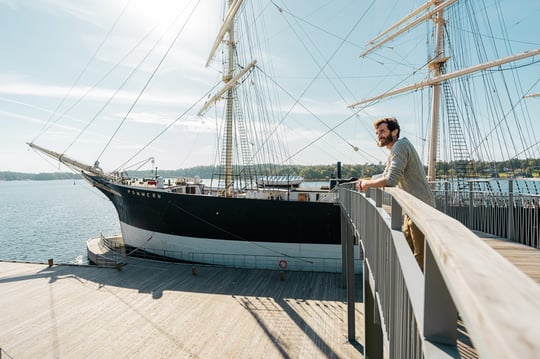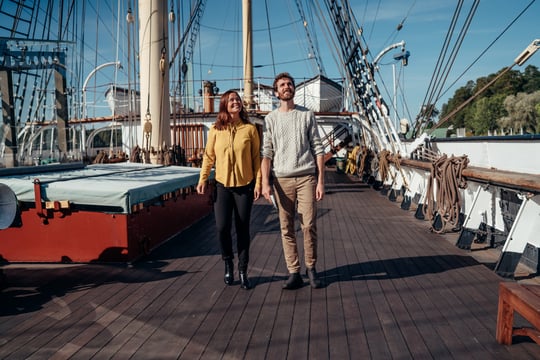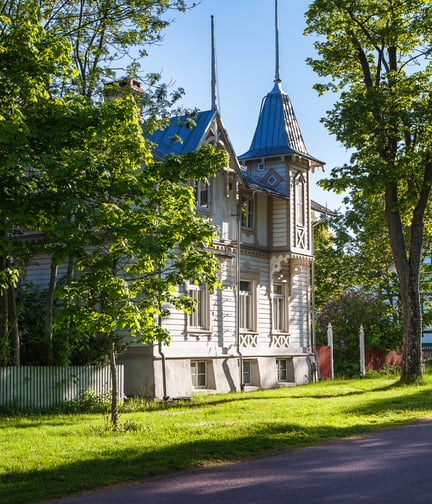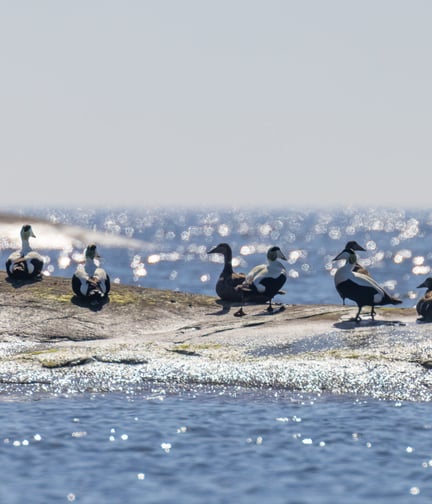Mariehamn – a City Built Around Maritime Heritage
The sailing ship Pommern and the Maritime Museum, the Maritime Quarter with its boatbuilding tradition and the bustling ferry traffic to the east and west. In Mariehamn, the maritime heritage is obvious for a visitor—and has been for a long time.
For 50 years it has stood there, in the Western Harbour, by the quay below the Maritime Museum and the classic Nautical restaurant. It’s Åland's most unique attraction and Mariehamn's foremost landmark, a monument to Åland maritime history. The four-masted barque Pommern, the only sailing ship of this size preserved in original condition in the entire world.
A footbridge leads from the Maritime Museum to the magnificent vessel that annually welcomes more than 40,000 visitors. Standing beside the ship is impressive, but it's not until you step aboard that you truly grasp its dimensions.
The experience begins on the weather deck, which served as the crew's quarters. Here, sailors worked day and night, sometimes risking their lives, forming friendships that lasted a lifetime. With a pair of headphones on, you can follow the audio tour from the simple crew's bunks to the captain's salon, eavesdropping on the sailors' conversations based on crew letters and diary entries. Here, Pommern's stories come to life as vividly as they can, a century after they occurred.
On Pommern, you experience seafaring life with all your senses. Through film clips about life on board and interviews with crew members, who are now few in number, you start to understand how demanding life could be on board.
At the same time, you ponder: How was it like for those who stayed ashore, waiting to reunite with their son, father, husband or brother after one, or maybe several years at sea, with no guarantee of a reunion?
History and Present meet in the Tall Ships Races
When a sailing ship returned from a long trip, many people came down to Western Harbour to welcome the ship and the sailors, who had experienced hard work, storms and challenging conditions during their long voyage.
The joy and excitement were palpable both ashore and on board. In July 2024, you could feel the same excitement in Western Harbour, when the international event The Tall Ships Races came to Mariehamn. With around 60 vessels in different size categories, the competition took over Mariehamn for four days, before the last race to Szczecin in Poland.
During these days, Åland's rich sailing history was recreated. As the ships with thousands of crew members and the public visited the city, the Mariehamn city centre turned into a one huge festival. Just like 100 years ago, there was a festive atmosphere in the air. With a bustling crowd in the harbor, the event was created with food, drinks, music, dance, and genuine sailor’s spirit.
Åland Maritime Tradition
For hundreds of years, shipping has shaped Åland and its people. Research suggests that Ålanders likely engaged in trade as far back as the Viking Age. During the Middle Ages, they primarily sailed to Turku and Reval in the east and Stockholm in the west.
The strategic location near the main fairway between Sweden and Finland played a significant role in the growth of Mariehamn as an important port and maritime centre. The location in the middle of the Baltic Sea combined with excellent harbours on both sides of the town contributed to Mariehamn becoming a vital harbour and a hub for shipping.
Ålandic cargo shipping took off in earnest after the mid 19th century. Several prominent shipowners chose to settle in Mariehamn, which had become the new centre on Åland after the village of Skarpans near Bomarsund fortress was destroyed in the 1856 war.
Partnerships, where dozens of owners shared the risks and profits of a single ship, became common during this period. Initially, these ships only sailed in the Baltic Sea, but the shipowners built ever-larger vessels, and trade routes extended to the North Sea and the Mediterranean. In 1865, the barque Preciosa from Eckerö became the first Ålandic ship to sail across the Atlantic.
The Golden Era of Sailing – Gustaf Erikson
After WWI, shipping experienced a global boom. Steamships were on the rise, but Ålandic shipowners went against the trend and acquired a number of deep-sea sailing vessels at very favourable prices.
One of the shipowners was Gustaf Erikson. Along with some partners, he established the shipping company Rederi AB Gustaf Erikson in 1913. Gustaf Erikson's acquisitions stood out because at a time when other shipping companies were investing in motorised vessels, he bought sailing ships from other companies.
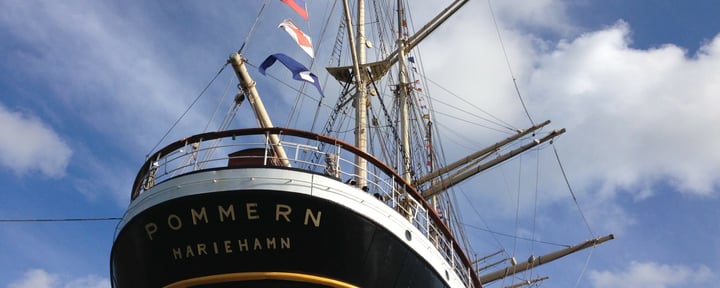
By 1935, Gustaf Erikson's fleet consisted of fifteen steel-hulled square-rigged sailing ships, eight smaller sailing ships, and six motor sailers. The sailing fleet, to which the sailing ship Pommern belonged, attracted worldwide attention, and the great grain races between Australia and England are described in numerous books.
During the period when sailing ships were used less frequently as cargo vessels, Gustaf Erikson, to the world's amazement, not only established a profitable shipping business with sail-powered merchant ships, but also managed to expand it. Between 1913 and 1947, he owned an incredible 66 merchant ships.
After WWII, the era of sailing ships came to an end and Gustaf Erikson's shipping company went down in history as the world's last sailing ship shipping company. After Erikson's passing in 1947, his son Edgar Erikson took over the business, and much of the fleet was replaced with modern steam and motor ships.
An Ålandic Cultural Heritage
At the time, Gustaf Erikson was Finland's largest ship owner and a prominent figure in Ålandic business. He was a meticulous ship owner who documented his business activities in great detail. His extensive and detailed correspondence provides valuable information about shipping and maritime history – the archive totaling 20 shelves of documents contains a variety of materials ranging from business letters to letters from ship crews from 1913 to 1947. In spring 2023, the archive was included in UNESCO's global Memory of the World program.
Shipping and ships are also well-documented at the award-winning Maritime Museum, established specifically to house items from the era of sailing ships. Here, you'll find souvenirs that sailors brought home from distant countries, ship models, the captain's salon rescued from the wrecked Herzogin Cecilie, navigation equipment as well as more modern artefacts, such as a life raft from a passenger ferry.
Modern Ferry Traffic and Shipping
In the 1950s, shipping companies cautiously made new investments, but it was in the 1960s that their fleets expanded and modernized dramatically with steam and motor vessels.
Ferry traffic to Mariehamn began in 1959 with s/s Viking, which sailed between Galtby in Finland, Mariehamn in Åland and Gräddö in Sweden. The s/s Viking was 99 metres long and could accommodate 88 passenger cars.
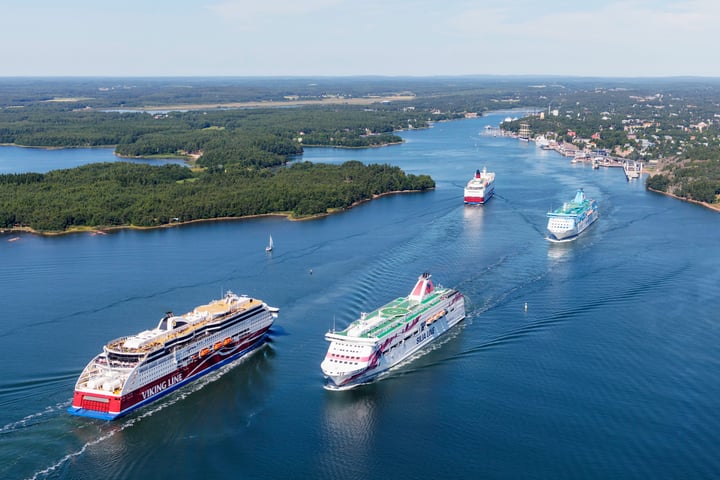
The development of ferry traffic exploded during the 1970s and 1980s when several large car ferries were built for Ålandic shipowners. For example, when Viking Line's M/S Mariella was launched in 1985, she was the largest car and passenger ferry in the world, measuring 177 metres in length and 28.4 metres in width.
Over the years, ferry tonnage has gradually increased, and the ferries have become larger and more luxurious. For instance, Finnlines' vessel Finnsirius has a length of 235 metres and a width of 33 metres. In late summer 2023, she was steered home from the Weihai shipyard in China, with who else if not an Ålandic captain at the helm!
The Future of Shipping
Perhaps it’s due to the rich maritime history and expertise, that Mariehamn now boasts a maritime school, the Alandica Shipping Academy, which trains new seafarers for global voyages as well as regional navigation. Ålandic sailors and captains now work all around the world, and their skills are highly regarded.
The Alandica Shipping Academy is unique in that it can offer its students an own training ship, M/V Michael Sars, a dedicated practice harbour and a Maritime Safety Centre visited by international students and maritime professionals. In this way, seamanship lives on in Ålandic society. Moreover, several shipping companies are based in Mariehamn, and many ships have Mariehamn as their home port.
The Maritime Quarter Celebrates the Boatbuilding Tradition
Maritime culture is prominently visible on the city's eastern shore as well. Here lies the Maritime Quarter, a significant cultural area celebrating Åland's maritime history. Its fundamental idea is to preserve and pass on the knowledge in ship building accumulated over the years to future generations.
Here, Ålanders' maritime heritage continues to be nurtured by traditional craftsmen and boatbuilders. It's a popular destination for both locals and visitors, blending old traditions with newer buildings. The Maritime Quarter's origins date back to 1904 but interestingly, most of the area was constructed as late as in the 21st century.
The Maritime Quarter features a boat harbour and activities like a ropewalk, blacksmithy, carpentry workshop and rigging workshop. It hosts a small-scale museum with maritime collections, handicrafts and small-scale commerce. During the summer, pizzerias, cafes, ice cream stands and food trucks attract both residents and visitors. Although the Maritime Quarter is an important recreational area, one of its key activities is still shipbuilding.
One of the most famous vessels built here is the schooner Albanus. The construction of Albanus began in 1986, and the ship was completed just in time for the festivities of The Tall Ships Races in the summer of 1988. When Albanus was launched during the event, it set an all-time attendance record for Åland. Two years later, the schooner Linden was built. With these newly constructed ships, interest in boatbuilding traditions was revived.
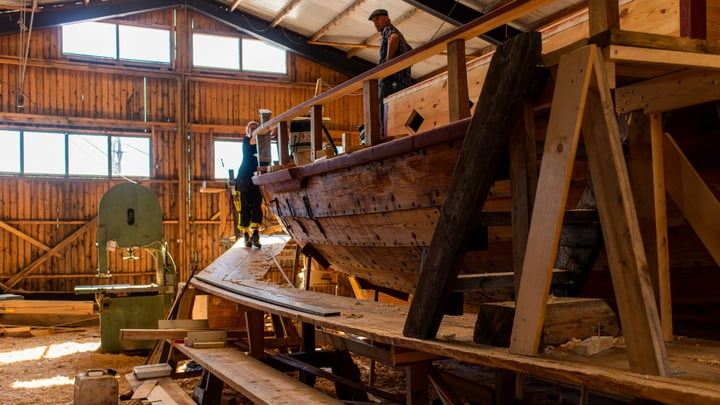
A total of around 40 boats have been built in the Maritime Quarter since its inception. The latest project at the shipyard is Emelia, Albanus's successor, which construction is still under development in 2024. The Maritime Quarter has also undertaken the restoration of ships beyond Åland, such as Finland's first museum ship, Sigyn, and the Estonian-Swedish ship Hoppet, which had its rigging restored.
For those interested in the area's maritime heritage, guided tours offer insights into its rich history and ongoing projects.
Much has happened and changed since Mariehamn was founded in 1861, but much still reminds us of the heyday of shipping. For example, the event the Tall Ships Races in July 2024. Once again, Åland experienced something that has touched the hearts of so many throughout history and holds a special place in their hearts. Some because of personal family history, others out of sheer pride in being part of a seafaring nation.

